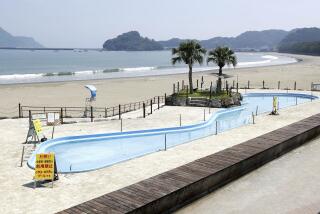Sun rises on a devastated Japan the day after earthquake, tsunami
- Share via
Saturday sunrise in Japan illuminated harrowing scenes of destruction across the island nation rattled by the strongest earthquake in its recorded history, with huge coastal swaths under water from tsunami waves and plumes of black smoke filling the skies from burning cars, homes and factories.
Japanese media reported that at least 1,000 were believed dead, thousands more injured and tens of thousands displaced by the three-story wall of water that crushed their homes and brought much of the modern country to a standstill.
Aftershocks from Friday’s 8.9-magnitude temblor and additional earthquakes as strong as 6.6 jolted the country before dawn.
Fires raged in the northeastern cities of Kesennuma and Sendai, with blazing buildings floating in the waters left by retreated tsunami waves that towered as high as three stories. NHK television showed scenes of conflagration at an oil refinery in Chiba Prefecture, near Tokyo, and of fire sweeping through a lot full of compact cars parked in Tokaimura.
Photos: Scenes from the earthquake
Despite minimal damage to Tokyo, the capital city that is the economic heart of Asia, the city was paralyzed by idled transit and sporadic telecommunications. Authorities said contact had been lost with four trains traveling along the northeastern coast.
In Fukushima Prefecture, a state of emergency was proclaimed after the 2:46 p.m. Friday earthquake knocked out a backup power system, depriving the Oganawa boiling water reactor facility of the energy needed to cool rising temperatures in the fuel rods. Although the temperature was running 50% over normal, at about 750 degrees Fahrenheit, it remained well below the 2,200-degree design limit for preventing “cladding failure,” said Margaret Harding, a veteran nuclear industry engineer familiar with the afflicted reactor from her work with General Electric.
“Remember, these are ceramic pellets. It takes a lot of heat to melt them,” Harding said of the nuclear fuel rods.
Officials of Japan’s Nuclear and Industrial Safety Agency said a release of accumulated vapor from the reactor posed no risk to people or the environment, despite raising the background radiation level 1,000 times normal.
More than 3,000 people living near the facility were evacuated as a precaution, Cabinet Secretary Yukio Edano told reporters.
Photos: Scenes from the earthquake
More to Read
Sign up for Essential California
The most important California stories and recommendations in your inbox every morning.
You may occasionally receive promotional content from the Los Angeles Times.














